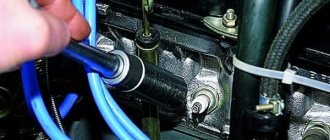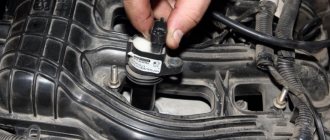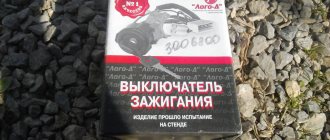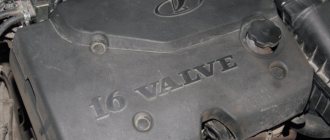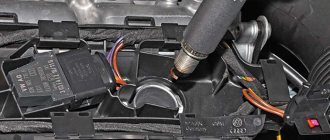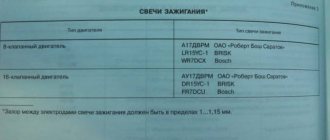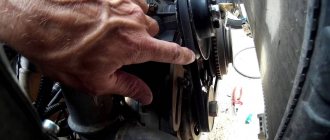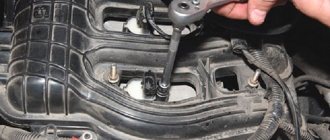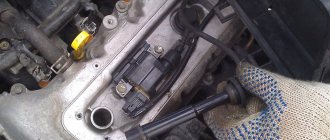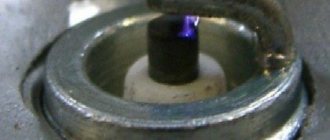Replacing spark plugs and setting the gap
For stable operation of the Niva 2121, 21213, 21214 injection and carburetor engines, it is necessary to change the spark plugs on time, since they are an integral important part of the engine that ignite the combustible mixture.
- The engine starts with difficulty, the starter turns for a long time.
- The engine jerks and stalls
- Power decreases
- Engine speed fluctuates
- Fuel consumption increases
- Denso Iridium Power.
- Bosch platinum
- BERU Ultra X
- BERU Ultra X Platin
- BERU UXT6
- DENSO W20TT
- Finwhale 510
- A17DVR analogue from NGK BPR6ES
- A 17 DVRM analogue from NGK BPR6ES-1
There are more positive reviews, of course, in the more expensive price category, as well as with platinum or iridium rods , which exceed the service life of simple ones by 70-80%, and need to be changed not after 20 but after 100 thousand km. which increases service life by 5 times.
- Brush
- Spark plug key for 21
- Gap adjustment gauge
- Pliers or hammer
How to set the spark plug gap in the field:
For carburetor Niva 2121 this gap is - 0.9 mm For injector 21214 - 1.11 mm
Insert a feeler gauge of the required size into the spark plug and tap it with a hammer if the gap is large, or lift it with pliers if it is small.
- The next step is cleaning, clear the wells of debris so that nothing gets into the block.
- We unscrew the old spark plugs, counterclockwise; if they are stuck, use Wd40 and repeat after 15 minutes.
- We install new spark plugs with the correct gap in the engine.
- If there is black soot deposits on the core, this means that the fuel you are using is of poor quality, or oil is getting into the combustion chamber, this may be due to worn piston rings, valve guides, oil seals.
- If soot covers the core together with the body, this indicates a disruption in the supply of the fuel-air mixture, we recommend checking the carburetor settings and changing the air filter.
- If the core is white, the ignition adjustment is incorrect.
- A melted core is the reason for the overheating of the car, so if your Niva is boiling over a couple of times, we recommend checking the spark plugs and paying attention to whether the engine is behaving differently, this happens, of course, extremely rarely, but forewarned is forearmed.
Video
Service
To keep the spark plugs in good working order for as long as possible, service them every 10,000 thousand km, clean them with a brush and adjust the gap if necessary.
Conclusion
You need to select candles according to your taste and color, as well as the thickness of your pocket, but you should remember that you shouldn’t save money and it’s better to pay once for good candles that will serve faithfully than to suffer from starting the car in the cold.
Malfunctions of the ignition system affect all modes of engine operation. When checking it, special attention should be paid to spark plug gaps, ignition timing, cleanliness of high-voltage wires, condition of the ignition coil and distributor connector, serviceability of vacuum and centrifugal regulators.
You need to wash the outside of the carburetor without disassembling it. Particular attention must be paid to the cleanliness of moving joints, damper axes, levers and rods. To wash the chambers and channels, it is recommended to completely disassemble the carburetor. During partial disassembly, dirt from the external surfaces may get inside the carburetor. To do this, use kerosene or special washing liquids and a brush with moderately stiff bristles. You can wash individual carburetor parts with acetone. Gaskets, diaphragms and rubber seals are not solvent resistant. These parts must be removed and washed separately and only in gasoline.
If there are old deposits in the carburetor channels, its body parts can be immersed in detergent compounds for several hours. To completely remove deposits, all channels after flushing must be blown with compressed air under high pressure (6-8 bar).
It is not recommended to wipe carburetor parts and cavities with a lint cloth. Even the smallest fibers separated from it fall into the channels and jets, which can lead to subsequent adhesion of dirt to them, reducing their throughput or clogging. Read it, like it!
Both the engine power and the stability of its operation, as well as fuel consumption, depend on the correctly set gap on the spark plugs. As is written in many operating instructions for the Niva VAZ 2121 car and its modifications, the optimal gap between the spark plug electrodes is 0.8 mm.
Alignment is done using a special probe, the thickness of which must be appropriate. Especially for this, along with other devices, I ordered a set of probes from Jonnesway, which contains 20 plates of various thicknesses.
Select the required thickness of the plate - probe:
and insert it between the electrodes of the spark plug so that the probe fits tightly, not without much effort:
After carrying out this procedure on my Niva, the engine became more stable at idle. Before this, the gaps were a little too high, which contributed to ignition breakdowns.
Spark plugs
Spark plugs
Post by ParaLanik » 04 Dec 2012, 12:46
Good afternoon everyone, I would like to hear feedback on the use of various spark plugs in our cars. Who is “lighting” which ones and what’s the catch?
I’ll start with myself - I bought the car with EZ A17DVRM immediately after running it in (2 thousand km), changed it to BPR6ES11 , 10 thousand became unstable XX. Changed it to DENSO W20TT - now 31 thousand km. — the engine works well.
However, winter is coming. Maybe it needs to be changed - who will say what? I myself am looking towards multi-electrode ones: either BERU Ultra X or BERU Ultra X Platin or BERU UXT6
or W20EPBR-S - I doubt them and the gap of 0.85 is too small for the injector, or NGK BUR6ET - similar problem with the gap.
Re: Spark plugs
Post by Sunny » 04 Dec 2012, 13:21
Re: Spark plugs
Post by T-Rex » 04 Dec 2012, 13:36
Re: Spark plugs
Post by Sash » 04 Dec 2012, 16:12
Re: Spark plugs
Post by Vladimir55 » 04 Dec 2012, 19:28
Re: Spark plugs
Post by Sunny » 05 Dec 2012, 06:35
Re: Spark plugs
Post by Sash » 05 Dec 2012, 09:20
Re: Spark plugs
Post by ParaLanik » 05 Dec 2012, 09:57
Re: Spark plugs
Post by Sunny » 05 Dec 2012, 12:54
Re: Spark plugs
Post by ParaLanik » 05 Dec 2012, 13:14
The most, the very thing that is needed. ( V-Line #13 ). Only here it is impossible to find something that is not a fake. I think maybe they haven’t yet learned how to fake its more expensive analogue? BPR6EIX11
I found a sign about the applicability of these spark plugs for our cars https://www.technicsavto.ru/site/?part=prim_ngk
Re: Spark plugs
Post by Sunny » 05 Dec 2012, 13:37
Re: Spark plugs
Post by AMPER » 05 Dec 2012, 17:54
Re: Spark plugs
Post by Slava N » 15 Dec 2012, 18:40
Re: Spark plugs
Post by Sunny » Dec 15, 2012, 06:49 pm
Re: Spark plugs
Post by AMPER » Dec 15, 2012, 7:15 pm
Re: Spark plugs
Post by Sunny » Dec 15, 2012, 7:24 pm
Re: Spark plugs
Post by Slava N » 15 Dec 2012, 20:35
Re: Spark plugs
Post by Zakonnik » Dec 29, 2013, 10:06 am
Re: Spark plugs
Post by Leon71 » Jun 01, 2014, 00:44
Re: Spark plugs
Post by Niva1600 » Jun 01, 2014, 10:46 am
Engine 1.6 carb OZONE, new wires are not oak (700 rubles). gas station 92. company 2000 I’ll tell you from personal experience.
1) Brisk candles - 170 rubles (4 pieces), in winter they start the car -30, the car runs well, the mileage of the candles is short, they quickly fail. Replace every 2000-5000. They are very afraid of soot. 2) Champion candles (Champion) - 330 rubles (4 pieces), start the car the same way - 30, the car runs exactly the same, The mileage of the candles is average, replacement every 5000, although I change 1 candle at a time due to carbon deposits, I just throw it away. Although it could be a candle OK.
I put the brisk together with the champion, they work the same way. It’s not a fact that brisque dies quickly, I used briskies mainly in winter. The consumption is the same. PS: You can clean the spark plugs with a can (Carburator Cleaner)
Spark plugs NGK for Niva 21214
The 1.7 liter injection engine with an electronic control system (ECM) of the Niva 21214 allows the installation of some models of NGK spark plugs.
B PR6ES-11 4824
Copper center electrode, one side electrode, noise suppression resistor.
Thread diameter - 14 mm
Thread length - 19 mm
The gap between the electrodes is 1.1 mm
Resistance - 5 KOhm
BPR6EGP-11 7084
Central electrode with platinum soldering. One side electrode. Noise suppression resistor.
Thread diameter - 14 mm
Thread length - 19 mm
The gap between the electrodes is 1.1 mm
Resistance - 5 KOhm
BPR6E V-Line #13 5339
Copper center electrode with V-shaped cutout. One side electrode. Noise suppression resistor.
Thread diameter - 14 mm
Thread length - 19 mm
The gap between the electrodes is 1.1 mm
Resistance - 5 KOhm
BPR6EIX-11 3903
Thin (0.6 mm) central electrode with iridium soldering. One side electrode. Noise suppression resistor.
Thread diameter - 14 mm
Thread length - 19 mm
The gap between the electrodes is 1.1 mm
Resistance - 5 KOhm
Notes and additions
— You can independently select NGK spark plugs for your car’s engine in the catalog on the official website of this manufacturer: www.ngk.de/nc/ru/podbor-produkcii/
— You can understand what the NGK spark plug markings mean by reading the article: “Decoding the NGK spark plug markings.”
Details about choosing spark plugs for Chevrolet Niva
It is recommended to replace it every 30 thousand, and the recommended imported analogue is the BRISK Super LR15YC spark plug, or LR17YC - this is for winter. However, in terms of price/quality ratio, there are now more interesting options. At one time, one authoritative publication compared 9 replacement options. But the reader will not immediately know which spark plugs work best on a Chevrolet Niva: if you buy the “best” BOSCH Platinum spark plugs, cold starts will become problematic.
We watch a video with conflicting reviews about NGK brand products.
What has already been tried
Let's consider 4 options.
"Brisky" after the first 15,000 km
We will only name the “cons”:
- BOSCH Platinum WR7DPX - starts more difficult than even with the A17DVRM, but then the engine works better than with others;
- BRISK Super LR15YC – durability will be 15-20 thousand, not 30;
- BOSCH Yttrium WR7DCX - something between the first two;
- A17DVRM - depending on your luck. It may fail at 5 thousand, but only one spark plug (not all).
There is a hypothesis that Platinum is Yttrium, which passed all the tests. This means that with “good” spark plugs our engine starts worse than with “regular” ones. Why not.
A good option from GM is WR8DCX+ spark plugs, that is, an analogue of A17DVRM. Rejection almost never occurs, and the start is better than with A17.
The point of the first paragraph is for the reader to understand: general recommendations are one thing, but the “2123” motor is something completely different.
DIY replacement instructions
To dismantle, first of all you will need a special key for removing the SZ. First you need to remove the ends of the wires from the spark plugs and clean all contacts from dust. The entire spark plug and the area around it must be thoroughly cleaned to prevent debris from getting into the cylinder.
Next, you need to remove the devices with a key and visually diagnose them for damage. You need to inspect both the electrodes and the threads. If there is noticeable darkening on the NW, it’s okay, but if there is no brownish coating, you should be alarmed. If black plaque is found, it must be removed. It indicates that engine oil has entered the engine cylinder.
When replacing, be sure to check the gap on the new SZ. If it doesn't quite fit, you can carefully bend the electrode on the side. This is a rather risky method, because you need to be as careful as possible and not damage the central electrode. Otherwise, the SZ will fail. After preparing the socket for the SZ, you need to insert it and tighten it with your fingers, and then tighten it with a wrench. Be careful here, otherwise the thread may break.
Price issue
The photographs below show several models of devices for the Chevrolet Niva, including their cost.
What is good for the 1.6 engine?
For the 2111 engine, the balance of forces looks like this:
- BOSCH Platinum WR7DPX
- "EZ" T17DVRM 1.0 (3 electrodes)
- NGK BPR6ES-11
- DENSO W20EPR-U11
- Ween 121-1370/KMR6C11
- BERU 14R-7DUX
- BRISK Super LR15YC
- Hola BH7CR11
- "Citron" A17DVRM
Based on this list, it is impossible to say which spark plugs are best for the Chevrolet Niva. What works best for one 8 valve (1.6) may not work for another (1.7).
The products of the Japanese brand DENSO were popular, but counterfeits began to appear, and now budget DENSO candles are no longer sold at all.
We choose spark plugs consciously
All products from the DENSO IRIDIUM POWER series have proven themselves well. For the “2123” motor, one option is suitable, IW20, but IK20 is already a turnkey “16”. The cost of the kit can exceed 90 euros. Do we need it?
On the left is a BOSCH SUPER 4 spark plug.
Those who bought spark plugs with four electrodes are happy. We are talking about the BOSCH SUPER 4 series and the WR78X version. But here, again, you will have to overpay. And that’s why they often choose NGK products. We are talking about the V-line line and option number 13. We need V-line 13 BPR6ES-11 spark plugs. Their service life in the “2123” engine can reach up to 60 thousand.
V-line 13 kit
Brand "NGK" for Niva Chevrolet
Up to 90% of all NGK products are produced in Japan. And approximately 9% are products of the French branch. There are NGK factories in 14 other countries. Well, spark plugs for VAZ cars should be produced in France - the factory is located in the suburbs of Orleans.
The box usually has a barcode on it, so V-line candles, as it turns out, are made in Holland. The country code is 087.
Expert recommendations
Niva Chevrolet injector with VAZ-2123 engine are equipped with A17DVRM spark plugs. This plant, despite the fact that it is located in Russia, belongs to Bosch. These German manufacturers have proven themselves well in the market.
It is important to consider some differences when choosing a SZ:
- EZ A17DVRM consists of Russian-made parts;
- APS A17DVRM consist of German-made parts.
To avoid confusion, you should always look closely at the markings. Speaking about the second option, one must also take into account the fact that APS A17DVRM are manufactured using advanced technologies. Among other things, they are distinguished by better processing of the electrodes, and therefore you can avoid problems with a running spark, which is typical for defective devices.
When choosing suitable products, you need to follow some rules:
- DENSO IW20 and NGK devices contain a sufficient amount of iridium, which has a beneficial effect on engine life.
- BOSCH WR78X parts accommodate four electrodes.
- GM WR8DCX are suitable for use in winter and summer. They are preferable to the aforementioned A17.
